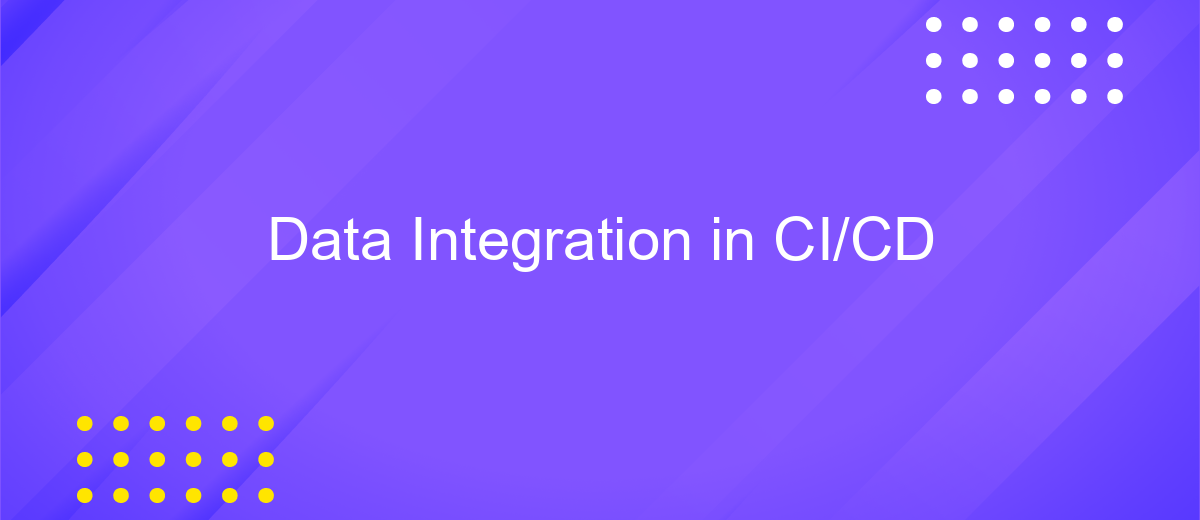Data Integration in CI/CD
Data integration in Continuous Integration and Continuous Deployment (CI/CD) is crucial for ensuring seamless and efficient software development workflows. By automating the merging of data from various sources, teams can enhance collaboration, reduce errors, and accelerate delivery times. This article explores the significance of data integration in CI/CD pipelines, its benefits, and best practices to optimize your development process.
Introduction
In the rapidly evolving landscape of software development, Continuous Integration and Continuous Deployment (CI/CD) have become essential practices for delivering high-quality software swiftly and efficiently. Data integration within CI/CD pipelines is a critical aspect that ensures seamless connectivity and data flow between various systems and tools. This integration enables teams to automate processes, reduce manual interventions, and maintain data consistency across the development lifecycle.
- Automated testing and validation of data
- Real-time monitoring and feedback
- Streamlined data migration and transformation
- Improved collaboration among development, operations, and data teams
By incorporating data integration into CI/CD pipelines, organizations can achieve greater agility and reliability in their software delivery processes. This approach not only enhances the efficiency of development cycles but also ensures that data-driven applications are robust, scalable, and capable of meeting the dynamic needs of the business. As a result, companies can deliver better products to market faster, with reduced risk and increased confidence.
Benefits of Data Integration in CI/CD

Integrating data within CI/CD pipelines offers significant benefits, enhancing both development and operational efficiency. By ensuring seamless data flow between various stages of the pipeline, teams can achieve faster and more reliable deployments. This integration allows for real-time monitoring and feedback, enabling quicker identification and resolution of issues. Additionally, it promotes better collaboration among development, testing, and operations teams, as everyone has access to the same data and insights, leading to more informed decision-making.
Moreover, utilizing services like ApiX-Drive can simplify the setup and management of these integrations. ApiX-Drive provides a user-friendly interface to connect disparate systems, automating data transfers without the need for extensive coding. This not only reduces the complexity of managing integrations but also ensures that data is consistently accurate and up-to-date. As a result, organizations can focus on innovation and continuous improvement, rather than being bogged down by manual data handling processes.
Challenges of Data Integration in CI/CD

Data integration in CI/CD pipelines presents a unique set of challenges that can hinder seamless operations and slow down the development lifecycle. Integrating data from various sources and ensuring its consistency and reliability requires meticulous planning and execution.
- Data Quality: Ensuring the accuracy, completeness, and consistency of data from multiple sources can be difficult.
- Data Security: Protecting sensitive data during integration and ensuring compliance with regulations is paramount.
- Scalability: Managing data integration processes that can scale with increasing data volumes and complexity.
- Latency: Minimizing delays in data processing to maintain the efficiency of the CI/CD pipeline.
- Tool Compatibility: Ensuring that different tools and platforms used in the CI/CD pipeline can seamlessly integrate with each other.
Addressing these challenges requires a combination of robust data management practices, advanced integration tools, and a clear understanding of the data flow within the CI/CD pipeline. By tackling these issues head-on, organizations can ensure a more efficient and reliable integration process, ultimately enhancing the overall performance of their CI/CD systems.
Best Practices for Data Integration in CI/CD

Effective data integration in CI/CD pipelines ensures seamless, automated workflows, enhancing both development speed and reliability. To achieve this, it is crucial to establish a solid foundation by understanding the data sources, formats, and integration points pertinent to your project.
Implementing robust data validation and transformation processes can significantly improve the quality and consistency of the data being integrated. Leveraging tools and frameworks that support these operations will streamline the integration process.
- Automate data integration tasks to minimize manual intervention and errors.
- Use version control for data schemas to track changes and maintain consistency.
- Monitor and log data integration processes to quickly identify and resolve issues.
- Ensure data security and compliance by implementing encryption and access controls.
By adhering to these best practices, you can optimize your CI/CD pipelines, ensuring that data integration is both efficient and reliable. This will ultimately lead to more robust and scalable software delivery processes.
Conclusion
In conclusion, integrating data within CI/CD pipelines is essential for enhancing the efficiency and reliability of software development processes. By automating data flows and ensuring seamless communication between different systems, teams can achieve faster release cycles and maintain high-quality standards. Implementing tools like ApiX-Drive simplifies the integration process, allowing for easy connection of various applications and data sources without the need for extensive coding knowledge.
The adoption of robust data integration strategies in CI/CD not only accelerates development but also minimizes the risk of errors and inconsistencies. As the landscape of software development continues to evolve, leveraging advanced integration services will be crucial for staying competitive and agile. Ultimately, the ability to seamlessly integrate data will empower organizations to deliver better products and services, meeting the ever-growing demands of the market.
FAQ
What is Data Integration in CI/CD?
Why is Data Integration important in CI/CD pipelines?
How can I automate data integration in my CI/CD pipeline?
What are the challenges of Data Integration in CI/CD?
How can ApiX-Drive help with Data Integration in CI/CD?
Time is the most valuable resource for business today. Almost half of it is wasted on routine tasks. Your employees are constantly forced to perform monotonous tasks that are difficult to classify as important and specialized. You can leave everything as it is by hiring additional employees, or you can automate most of the business processes using the ApiX-Drive online connector to get rid of unnecessary time and money expenses once and for all. The choice is yours!

